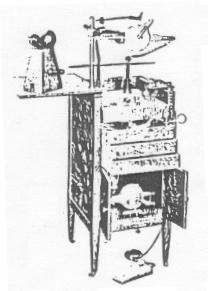




Much of the foregoing is more theoretical than it is practical
and I have finally come to the conclusion that a medium vacuum electrode
(purple tinge) answers all practical purposes, and this is what I am now
using.
Vacuum tubes are ordinarily made in a single chamber,
the tube fitting into the socket of a handle that is used for all the different
forms. Some tubes have a leading-in wire and others, instead of having
a single chamber in the tube, have the vacuum divided into two chambers
the size of the circumference of the tube, connected by a small tube, possibly
the size of a small pencil, and surrounded by a chamber that is not a vacuum.
These latter are known as insulated tubes.
The tubes used most frequently are shown in Fig. 20.
No. 1 is the body tube, which is used also in treating face and scalp.
No. 2 is the rectal tube; 3, vaginal; 4, nasal; 5, urethral or aural; 6,
throat. In place of No. 1, No. 11, Fig. 21 will be found equally useful
and in some instances superior on account of the ridges around the depression,
enabling it to be used where it would be difficult to place the body tube.


Insulated Tubes. The advantage of the insulated
tube which I have been in the habit of calling the Titus tube, because
I believe it was first designed by Dr. Titus, is that with this tube the
current may be introduced without loss into an orifice of the body.
Take a plain vacuum tube and attach to the current and when it is lighted
up, surround it with the thumb and forefinger and it will be observed that
there is no light beyond the point of contact. It stands to reason,
therefore, that if such a tube were introduced, for instance into the rectum,
the point of contact with the body would draw off much of the current and
the surface within the body would receive but little treatment. For
this reason with the insulated tube the opening of the orifice comes in
contact with the non-vacuum part of the tube and the end of the tube where
the vacuum exists thus conveys all of the current in at the desired point.
I have been taken to task for my statement above, on the
ground that contact with the encircling finger possesses no capacity.
It simulates, however, the conditions of certain orificial treatments and
after trying the experiment referred to, I am sure the physician will resort
to the use of insulated tubes for rectal and other orificial work.
The principal forms of insulated tubes in use are shown
in Fig. 21. No. 7 is for the ear; 8, rectal, or prostatic; 9, post-nasal;
10, for vagina or uterus; 11, prostatic or for general surface use; 12.
Urethral or aural; 13, nasal.
The Adjustable Socket Handle. The ordinary
holder for high frequency tubes consists of a straight handle with a metal
socket into which the tube is received as shown in Fig. 20. This
is suitable for holding electrodes that are applied to the surfaces of
the body, but for most conditions I prefer a handle with a movable or adjustable
socket. Fig. 20. This socket may be placed at any angle to
the handle that may be desired and with a thumb screw made secure at this
point necessary. The advantage of this will be discussed in detail
in Chapter VII., when considering the special technique for various portions
of the body.
The latest type of my adjustable handle is shown in Fig.
24. It is of spring steel and accommodates tubes of varying diameters.
Author’s Spatulate Tubes. I have recently
designed the tubes shown in Fig. 27. They end in a flattened spatulate
extremity. In the body tube the end is at an angle with the main
tube, thus making it much handier to use than the regulation type of body
electrode.

The vaginal, prostatic and rectal tubes are similar in shape, but are straight. They vary only in size and are made both plain and insulated.

The physician who has been using vaginal and prostatic tubes will readily perceive the advantages of the larger flat surface. Either of these tubes will be found quite satisfactory for surface applications.


